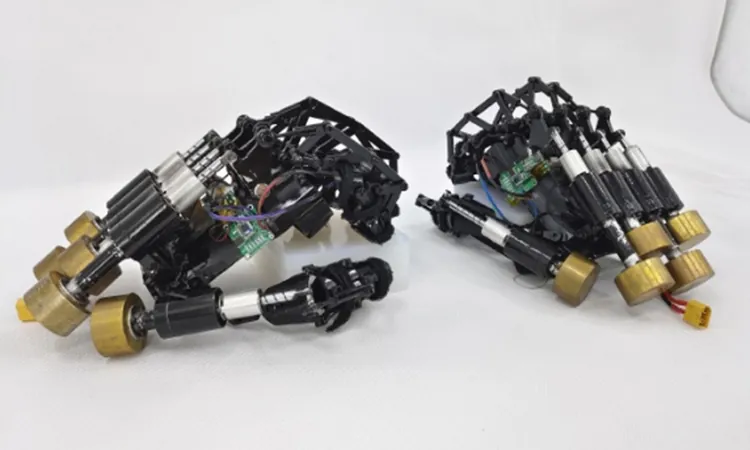
Breakthrough Nonmotorized Robotic Hand Exoskeleton Promises Game-Changing Applications in Rescue and Beyond
2025-09-22
Author: Sarah
Revolutionary Design by Chinese Researchers
A cutting-edge team from the University of Science and Technology of China has unveiled a groundbreaking set of nonmotorized robotic hand exoskeletons. These innovative devices are specifically engineered to tackle the limitations of human hand strength and fatigue, enabling users to effortlessly lift heavy objects, including slate slabs weighing over 200 kilograms.
Transforming Rescue Operations
Published findings in the prestigious IEEE Transactions on Robotics reveal that these robotic hand exoskeletons utilize advanced magnetorheological (MR) actuators to deliver exceptional grip support and significantly enhance endurance. Unlike typical motorized exoskeletons, which often struggle with generating high gripping force, these new exoskeletons showcase a superior gripping capability and a level of efficiency that could drastically change rescue efforts.
The Future of Emergency Response
In post-earthquake scenarios where heavy debris hampers rescue operations, these exoskeletons could prove invaluable. The research team conducted simulated earthquake rescue missions that demonstrated a remarkable reduction in muscle strain for users. Participants wearing the devices noted a 41.8% increase in grip strength without the need for external power, coupled with a significant decrease in hand fatigue during demanding tasks.
Unprecedented Performance Metrics
The MR actuator showcased a peak holding force of 1046 N with only 5 watts of power input, outstripping traditional methods by an astonishing tenfold in force-to-power ratio. This not only means effective operation but also a staggering 97.7% reduction in energy consumption for comparable holding force.
Beyond Earth: Opportunities in Space Exploration
Beyond earthly applications, the potential for deep space exploration is immense. Dr. Sun Shuaishuai, the team's leader, outlined plans to enhance these exoskeletons with human intention recognition technology. This would allow for precise adjustments in grip based on user intentions, making them even more versatile.
What’s Next?
The team is committed to further developing this technology by incorporating lightweight composite materials and advanced 3D printing techniques to improve the exoskeleton's design while maintaining structural integrity. Their goal is to make the device mimic human hand movements closely, minimizing any discomfort or slippage.
A New Era of Robotics Awaits
As these nonmotorized hand exoskeletons move closer to reality, the implications for rescue missions, labor-intensive tasks, and even space travel are monumental. The capabilities brought forth by this innovation not only promise to improve efficiency but could also save countless lives in critical situations.

 Brasil (PT)
Brasil (PT)
 Canada (EN)
Canada (EN)
 Chile (ES)
Chile (ES)
 Česko (CS)
Česko (CS)
 대한민국 (KO)
대한민국 (KO)
 España (ES)
España (ES)
 France (FR)
France (FR)
 Hong Kong (EN)
Hong Kong (EN)
 Italia (IT)
Italia (IT)
 日本 (JA)
日本 (JA)
 Magyarország (HU)
Magyarország (HU)
 Norge (NO)
Norge (NO)
 Polska (PL)
Polska (PL)
 Schweiz (DE)
Schweiz (DE)
 Singapore (EN)
Singapore (EN)
 Sverige (SV)
Sverige (SV)
 Suomi (FI)
Suomi (FI)
 Türkiye (TR)
Türkiye (TR)
 الإمارات العربية المتحدة (AR)
الإمارات العربية المتحدة (AR)